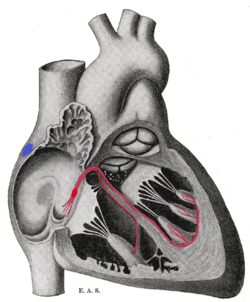Bundle of His
| Bundle of His | |
|---|---|
 Isolated Heart conduction system showing Bundle of His | |
 Heart cut away showing Bundle of His
Schematic representation of the atrioventricular bundle of His. The bundle, represented in red, originates near the orifice of the coronary sinus, undergoes slight enlargement to form the AV node. The AV node tapers down into the bundle of His, which passes into the ventricular septum and divides into two bundle branches, the left and right bundles. Sometimes the 'left and right bundles of His' are called Purkyně or Purkinje fibres. The ultimate distribution cannot be completely shown in this diagram. | |
| Details | |
| Identifiers | |
| Latin | fasciculus atrioventricularis |
| MeSH | D002036 |
| TA98 | A12.1.06.005 |
| TA2 | 3955 |
| FMA | 9484 |
| Anatomical terminology | |
The bundle of His, known as the AV bundle or atrioventricular bundle, is a collection of heart muscle cells specialized for electrical conduction that transmits the electrical impulses from the AV node (located between the atria and the ventricles) to the point of the apex of the fascicular branches. The fascicular branches then lead to the Purkinje fibers which provide electrical conduction to the ventricles, causing the cardiac muscle of the ventricles to contract at a paced interval.
Etymology
These specialized muscle fibres in the heart were named after the Swiss cardiologist Wilhelm His, Jr., who discovered them in 1893.[1][2]
Function
This bundle is an important part of the electrical conduction system of the heart as it transmits the impulse from the sinoatrial (SA) node (pacemaker) located in the right atrium to the rest of the heart. The intrinsic rate of the Bundle of His is between 40 - 60 bpm.[3] The bundle of His branches into the three bundle branches: the right, left anterior and left posterior bundle branches that run along the interventricular septum. The bundles give rise to thin filaments known as Purkinje fibers. These fibers distribute the impulse to the ventricular muscle. Together, the bundle branches and Purkinje network comprise the ventricular conduction system. It takes about 0.03-0.04s for the impulse to travel from the bundle of His to the ventricular muscle.
Pathology
If the Bundle of His is blocked, it will result in dissociation between the activity of the atria and that of the ventricles, otherwise called a third degree heart block. The other cause of a third degree block would be a block of the right, left anterior, and left posterior bundle branches. A third degree block is a very serious medical condition that will most likely require an artificial pacemaker.
His Bundle Pacing
Direct His-Bundle pacing has produced synchronous ventricular depolarization and improved cardiac function relative to apical pacing.[4]
In some patients with atrial fibrillation and a fast ventricular rate, as a last ditch effort to control the heart rate, electrophysiologists perform AV node modification / ablation following a pacemaker placement.[citation needed]
See also
References
- ^ synd/3490 at Who Named It?
- ^ W. His, Jr. Die Thätigkeit des embryonalen Herzens und deren Bedeutung für die Lehre von der Herzbewegung beim Erwachsenen. Arbeiten aus der medizinischen Klinik zu Leipzig, Jena, 1893: 14-50.
- ^ AnatomyBundleHis
- ^ Pramod Deshmukh, MD (29 February 2000). "Permanent, direct His-bundle pacing: a novel approach to cardiac pacing in patients with normal His-Purkinje activation". Circulation. 101 (8): 836–7. PMID 10694526. Retrieved 2008-10-08.
{{cite journal}}: Unknown parameter|coauthors=ignored (|author=suggested) (help)
External links
- . GPnotebook https://www.gpnotebook.co.uk/simplepage.cfm?ID=-1469382599.
{{cite web}}: Missing or empty|title=(help) - Atlas image: ht_rt_vent at the University of Michigan Health System - "Right atrioventricular bundle branch, anterior view"
- Template:EMedicineDictionary
- Scheinman MM, Saxon LA (2000). "Long-term His-bundle pacing and cardiac function". Circulation. 101 (8): 836–7. PMID 10694517.
- thoraxlesson4 at The Anatomy Lesson by Wesley Norman (Georgetown University) (thoraxheartinternalner)
- http://www.healthyheart.nhs.uk/heart_works/heart03.shtml
♥
